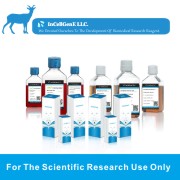

Overview
| Permits and Restrictions | |
|---|---|
| Organism | Homo sapiens, human |
| Tissue | lung |
| Product Format | frozen |
| Morphology | epithelial |
| Culture Properties | adherent |
| Biosafety Level |
1
Biosafety classification is based on U.S. Public Health Service Guidelines, it is the responsibility of the customer to ensure that their facilities comply with biosafety regulations for their own country. |
| Disease | mucoepidermoid pulmonary carcinoma |
| Age | 32 years |
| Gender | female |
| Ethnicity | Black |
| Applications |
The line has been selected as a prototype for transfecting human subgenomic fragments into human cells for studying the role of HBV and its individual genes in the pathogenesis of viral hepatitis and liver cancer.
|
| Storage Conditions | liquid nitrogen vapor phase |
Properties
| Karyotype | This is a human cell line with near-diploid chromosome counts. The modal chromosome number was 47, occurring in 36% of cells. The rate of cells with a higher ploidy count was 3.9%. Twelve markers were common to most cells. Among them were del(1) (q32.1), der (5)t(5;13) (p15.33;q11), i(5p), der(1)t(1;?) (p34.3;?) and der (6)t(6;7) (p25.3;q21.2). All markers were present in single copy per cell. Normal N1 and N6 were absent. There were two normal X chromosomes. No other abnormalities were detected. |
|---|---|
| Derivation |
This line was derived from a lymph node metastasis of a pulmonary mucoepidermoid carcinoma. The cells were isolated in a chemically defined medium (HITES) and later adapted to growth in media supplemented with serum.
|
| Clinical Data |
32 years
Black
female
|
| Genes Expressed |
keratin; vimentin,The cells retain their mucoepidermoid characteristics in culture as determined by their ultrastructure and expression of multiple markers of squamous differentiation.
TANK cells show reactivity with human alloantisera specific for the HLA A1, A3, A10, A19, B12, B17, B22 and B40 cross-reactive groups.
|
| Cellular Products |
keratin; vimentin
|
| Tumorigenic | Yes |
| Effects |
Yes, in nude mice; tumors histologically resemble the original biopsy specimen and retain mucoepidermoid features
|
| Virus Susceptibility |
Hepatitis B virus |
| Comments |
The cells retain their mucoepidermoid characteristics in culture as determined by their ultrastructure and expression of multiple markers of squamous differentiation.
The cells support the growth of hepatitis B virus and are negative for L-DOPA decarboxylase.
The cells stain positive for keratin and vimentin and are mucicarmine positive but are negative for neurofilament triplet protein.
|
Background
| Complete Growth Medium |
The base medium for this cell line is ATCC-formulated RPMI-1640 Medium, ATCC 30-2001. To make the complete growth medium, add the following components to the base medium: fetal bovine serum (ATCC 30-2020) to a final concentration of 10%. |
|---|---|
| Subculturing |
Volumes are given for a 75 cm2 flask. Increase or decrease the amount of dissociation medium needed proportionally for culture vessels of other sizes.
Subcultivation Ratio: A subcultivation ratio of 1:3 to 1:8 is recommended
Medium Renewal: Every 2 to 3 days
|
| Cryopreservation |
Freeze medium: Complete culture medium, 95%; DMSO, 5%
Storage temperature: liquid nitrogen vapor phase
|
| Culture Conditions |
Temperature: 37��C
Atmosphere: air, 95%; carbon dioxide (CO2), 5% |


